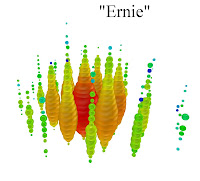http://en.wikipedia.org/wiki/IceCube_Neutrino_Observatory wrote:
<<IceCube is sensitive mostly to high energy neutrinos, in the range of 10
11 to about
1021 eV 
Estimates predict a neutrino event about every 20 minutes in the fully constructed IceCube detector.
IceCube is more sensitive to muons than other charged leptons, because they are the most penetrating and thus have the longest tracks in the detector. Thus, of the neutrino flavors, IceCube is most sensitive to muon neutrinos. Electron neutrinos typically scatter several times before losing enough energy to fall below the Cherenkov threshold; this means that they cannot typically be used to point back to sources, but they are more likely to be fully contained in the detector, and thus they can be useful for energy studies. These events are more spherical, or "cascade"-like, than "track"-like; muon neutrinos are more track-like.
Taus can also create cascade events; but are short-lived and cannot travel very far before decaying, and are thus usually indistinguishable from electron cascades. A tau could be distinguished from an electron with a "double bang" event, where a cascade is seen both at the tau creation and decay. This is only possible with very high energy taus. Hypothetically, to resolve a tau track, the tau would need to travel at least from one DOM to an adjacent DOM (17 m) before decaying. As the average lifetime of a tau is 2.9×10
−13 s, a tau traveling at near the speed of light would require 20 TeV of energy for every meter traveled. Realistically, an experimenter would need more space than just one DOM to the next to distinguish two cascades, so double bang searches are centered at PeV scale energies. Such searches are under way but have not so far isolated a double bang event from background events.
However, there is a large background of muons created not by neutrinos from astrophysical sources but by cosmic rays impacting the atmosphere above the detector. There are about 10
6 times more cosmic ray muons than neutrino-induced muons observed in IceCube. Most of these can be rejected using the fact that they are traveling downwards. Most of the remaining (up-going) events are from neutrinos, but most of these neutrinos are from cosmic rays hitting the far side of the Earth; some unknown fraction may come from astronomical sources, and these neutrinos are the key to IceCube point source searches. Estimates predict the detection of about 75 upgoing neutrinos per day in the fully constructed IceCube detector. The arrival directions of these astrophysical neutrinos are the points with which the IceCube telescope maps the sky. To distinguish these two types of neutrinos statistically, the direction and energy of the incoming neutrino is estimated from its collision by-products. Unexpected excesses in energy or excesses from a given spatial direction indicate an extraterrestrial source.>>
 HEAPOW: High Energy Ghost Particles from Outer Space (2013 May 20)
HEAPOW: High Energy Ghost Particles from Outer Space (2013 May 20)

 > 1016
> 1016
